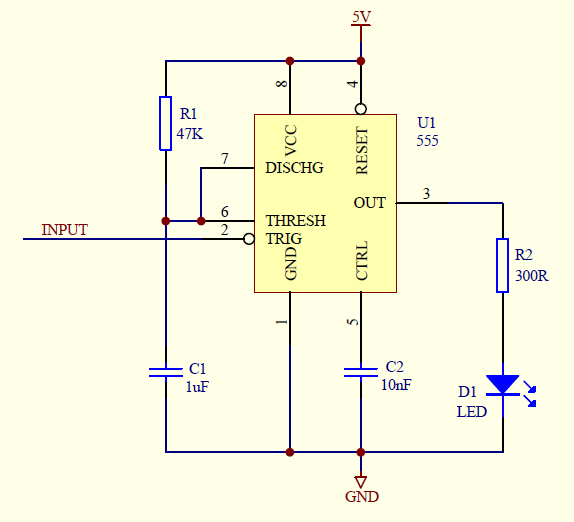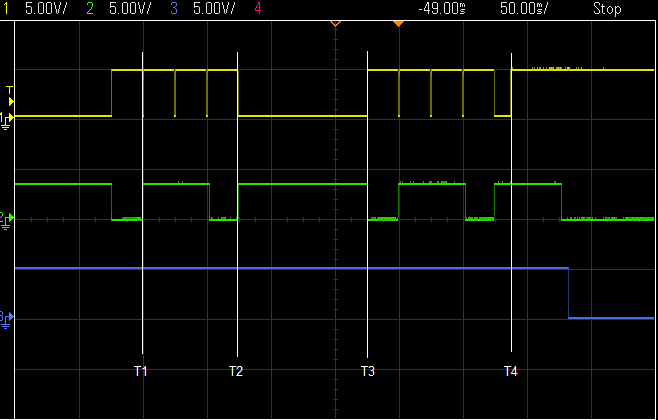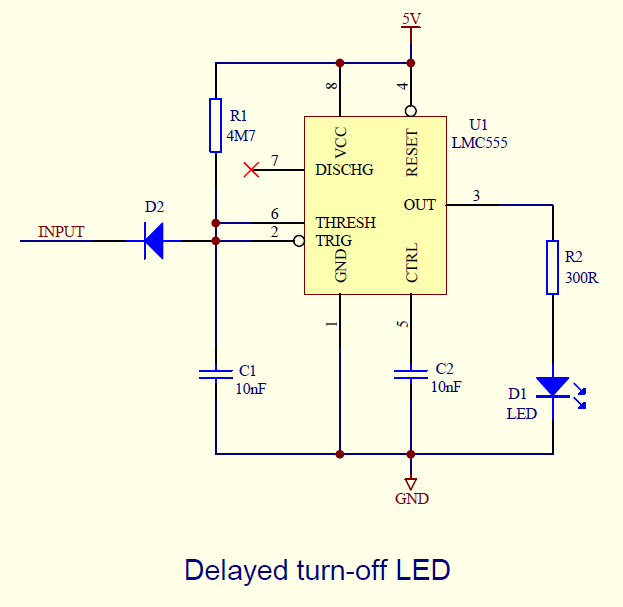The standard monostable circuit is shown below driving an LED.

A short low pulse on the input causes the output to go high and the LED to light for the time period defined by R1 and C1 (50ms for the values shown). However this circuit has some limitations around the TRIG pin described in the datasheet, the main two are highlighted below.

If the input pulse is longer than the RC time period, the output goes low (LED off) as soon as the input returns to the high state. In other words, if you keep TRIG low for too long, the output is no longer delayed by the RC time period because the time has already expired (C1 has charged). I call this the 'long trigger' limitation.
One way to overcome the long trigger limitation is to drive the TRIG pin through a capacitor to ensure the pulse is always shorter than the RC time period. Unfortunately this approach prevents the LED being kept on by a permanently low input. In applications such as clipping/overload detection, the LED should light for any length of overload including indefinite.
Another approach is to gate the TRIG pin with the output so the input pulse is always shorter than the RC time period. This is also tricky to engineer because there is a minimum low time for the trigger pulse (20ns) so the gating itself needs to be delayed. Furthermore, this method is only suitable if the circuit is running at logic levels or a discrete gate is needed. The component count is increasing !
In addition, a 'repeated trigger' limitation exists. If the timer has been started with a short TRIG pulse, further short trigger pulses are ignored until the time is complete - the trigger doesn't restart the timer. If the application requires the timing period to be reset so it never completes, this limitation is much harder to work around.
A circuit that should be simple to implement with a 555 is a software watchdog. The behaviour should be such that, as long as software drives TRIG low within the time period, the 555 output should remain high. If the software crashes, the output goes low and resets the CPU but it doesn't work because of these two limitations.

Top: Input signal (TRIG)
Middle: 555 output with datasheet monostable circuit
Bottom: 555 output with alternative monostable circuit
With the standard monostable circuit, the low trigger at T1 causes the output to go high for 50ms, then subsequent triggers are ignored until the output goes low, then finally the trigger at T2 is recognised by the 555. Despite multiple triggers, using the standard circuit, the output always goes low after the RC time period. This demonstrates the repeated trigger limitation.
Between T2 and T3, the trigger is low for longer than 50ms and the output goes low at T3 with no further delay. This demonstrates the long trigger limitation.
When I designed an amplifier clipping detector, I found an alternative way to use the 555 which lights an LED for long enough to be visible when the signal briefly clips (standard behaviour) and keeps it lit between brief pulses (no repeated trigger limitation) and also when the signal is in an indefinite overload state (no long trigger limitation). The overload LED only turns off when there has been a minimum period without clipping regardless of how long the overload state persists.
The circuit is shown below and the behaviour of the new circuit is shown on the bottom scope trace. When the trigger stops going low at T4, the timer starts and the 555 output goes low 50ms later. All the short and long trigger pulses before this point have restarted the timer. In this circuit, a low output corresponds to the good state (no clipping), the opposite of a watchdog.

This alternative circuit turns the time delay process on its head. Instead of a low TRIG signal starting the timer, it inhibits the timer. The input is connected to the RC and the C is prevented from charging when TRIG is low. In this state, the 555's output is high (LED on) and stays high while TRIG is low. Once TRIG is released, C1 is free to charge and the output goes low after the RC period.
To make this work properly, C1 must not be charged by the input when it is high so a diode (D2) or an open-collector drive is needed. In addition, we cannot use the 555's DISCHG pin. Also note that in this configuration, pins 2 and 6 are connected together in contrast to the standard circuit where pins 6 and 7 are connected together.
A short low pulse on the input discharges C1 which turns on the LED and keeps it on until the input is high for long enough. The timer only starts once the input goes high and further low pulses reset the timer so the LED always stays on for 50ms after the input goes high. The above circuit meets the brief and can be used whenever a robust turn-off delay is required with no unexpected output transitions such as the software watchdog described earlier.
For low voltage operation, D2 should be a schottky type. The current flowing through D2 as the input goes low can be substantial and a resistor might be needed in series with the diode to protect the driver, particularly at higher supply voltages. For example, with a 15V supply a 750 ohm resistor limits the current to 20mA. When using a protection resistor, R1 should be as high as possible and C1 as small as possible to allow the protection resistor to discharge C1 as quickly as possible. For circuits operating above the audio range, C1 must be in the low nF range, which implies that for delays as long as 50ms, R1 must be in the Meg ohm range. The CMOS version of the 555 works better with high resistor values.

The final clipping detector circuit is shown above. An LM393 dual comparator is used as a window detector with the outputs going low when the positive or negative limits are reached. The limits are set by R4/R5/R6 at +/-10V. The LM393 has open-collector outputs so there is no need for a TRIG diode and R3 limits the current in the LM393 output transistors to 20mA when C1 discharges.
The 555 is powered from the negative supply due to the comparator outputs going negative (-15V is ground as far as the 555 is concerned). This circuit is powered from +/-15V but will happily work at lower voltages if R4/R5/R6 are adjusted for the desired clipping levels. The LED stays on for approx. 50ms, R2 should be chosen for the desired LED current at the supply voltage used. The circuit works from DC to around 100kHz with accurate levels and is still functional at 1MHz where the input waveform needs to be about 1V higher before D1 lights. Note that 15V is the absolute maximum supply voltage for the 555.
I have used the CMOS version of the 555. It has some advantages over the original design, principally lower power consumption and it doesn't have a problem with shoot-through current at the output which introduces power supply noise. In my application, I didn't want any noise to get into the amplifier input so I used a CMOS 555. However, the pulse stretching design described here works just as well on all types of 555. I tested it again on an original 1970's vintage Signetics NE555 when writing this article.
Postscript
It is hard for me to believe that more than 50 years after the 555 was designed, nobody has previously used this exact solution to one of the problems described. However, I don't recall ever seeing it in any books, datasheets or application notes and I couldn't find this solution online. I hope that this design idea adds to the long list of ways a 555 can be configured and some of you find it useful (or at least interesting).